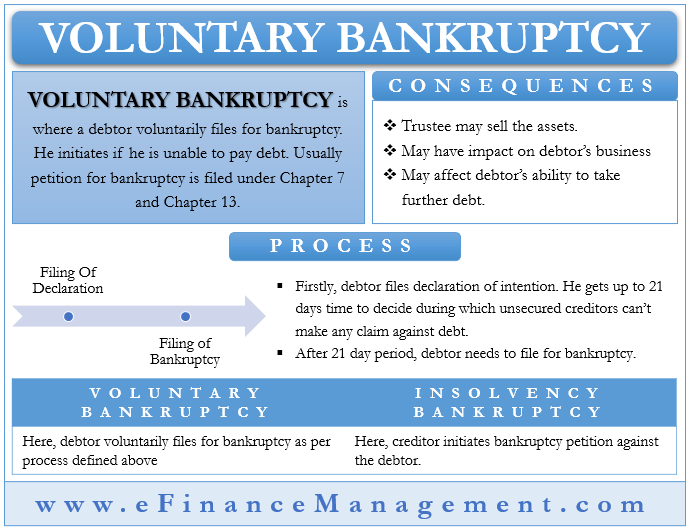As the word suggests, voluntary bankruptcy is when a debtor voluntarily files for bankruptcy. In this case, the debtor himself files the bankruptcy petition, unlike cases where creditors initiate action against debtors’ wishes. A debtor goes for such bankruptcy if they are unable to pay the debt.
It is the most popular form of bankruptcy. In fact, when people talk about bankruptcy, it is very likely they are referring to voluntary bankruptcy only.
Debtors, in this case, decide to file bankruptcy and then file a petition for the same. Usually, it is Chapter 7 or Chapter 13 petition that the debtor goes for. They have other options as well, such as Chapter 11, which is for business reorganization, and Chapter 12, which is for family farmers and fishermen.
How Voluntary Bankruptcy Works?
The process for voluntary bankruptcy starts after a debtor who believes that he can’t pay or he will not be able to make complete payment to the creditors approach the court. The filing of voluntary bankruptcy is very different from involuntary bankruptcy, which is initiated by a creditor.
Those with unmanageable debt can go for voluntary bankruptcy. Doing this will give them time to evaluate other options. Also, it ensures temporary protection to the debtor from any enforcement action creditors may take to recover their dues.

Filing of Declaration
A debtor first needs to file a declaration of intention (DOI) to start the process. After this, a debtor generally gets up to 21 days’ time to decide if they want to move ahead with the bankruptcy or take any other action, or still, they have a plan to settle the dues without moving forward. During this period, the unsecured creditors can’t make or file any case against the debtor for the non-payment of the debts.
The debtor can use this period to evaluate other options, negotiate terms with the creditors, or take actions so as to avoid the option of entering into the Bankruptcy Act 1966.
Filing of Bankruptcy
After the end of the 21-day period, a debtor needs to file for bankruptcy, and if the authorities accept the application, then the debtor gets bankrupt. A debtor can’t change their decision once the authorities accept their application. The authorities then appoint a trustee to manage the bankruptcy who will take over all of the debtors’ assets. Now, the trustee will decide on how to utilize the assets to pay against the debt.
The bankruptcy period generally lasts for up to three years. But, in certain cases, it may extend as well. The debtor gets a discharge once the bankruptcy is over, but the name stays forever in the records.
Voluntary Bankruptcy for Corporations
In case a corporation goes bankrupt, there is a process to ensure payment to the stakeholders. The process starts with giving assets first to the secured creditors or lenders having collateral on loan to the corporation. If the assets fell short of compensating the creditors, then they can get the balance payment from the corporation’s remaining liquid assets.
After the payment to the secured creditors, the next in line for payment are the unsecured creditors. The last in the line is the common stockholders. They will get the payment if any assets still remain after paying off all the debts.
Like an individual, a corporation also has the choice to file for Bankruptcy under various chapters of the Act, Chapter 7, Chapter 11, or Chapter 13. It depends upon the objective of bankruptcy and the likely plan of action for paying off the creditors. The first is for liquidating assets, the second is for corporate reorganizations, and Chapter 13 is for lowered debt covenants.
Consequences
Following are the consequences of filing the Voluntary Bankruptcy:
- The trustee may sell the assets.
- It may have an impact on debtors’ business and income.
- It may affect the debtors’ ability to get further credit.
Voluntary vs. Involuntary Bankruptcy
Involuntary bankruptcy, as the word suggests, is enforced onto the debtor. In this, the creditor initiates the bankruptcy petition against the debtor. However, there are some limitations when a creditor can’t initiate such a bankruptcy.
Unlike voluntary, a creditor can’t file bankruptcy under Chapter 13. Instead, they can do so only under Chapter 7. It is further to be understood that a creditor can’t file a bankruptcy petition against family farmers or fishermen. Nor can they move a petition against a married couple. Also, a creditor needs to meet certain qualifications in order to move ahead with involuntary bankruptcy.
There is also a technical bankruptcy. In this, even though a person or a company breaches their financial obligations, it hasn’t yet been declared in court.
Continue reading – What does a Bankruptcy Cost?
Final Words
Before you go for voluntary bankruptcy, it is advisable that you speak to an adviser or an expert first. Speaking to an expert will ensure that you have considered all alternatives and that you are making the right decision.

